
First published on the occasion of the exhibition
‘Michael Craig-Martin’
Royal Academy of Arts, London 21 September – 10 December 2024
Lead supporter
Generously supported by


First published on the occasion of the exhibition
‘Michael Craig-Martin’
Royal Academy of Arts, London 21 September – 10 December 2024
Lead supporter
Generously supported by
Batia and Idan Ofer
The Michael Craig-Martin Supporters Circle:
Lord and Lady Davies of Abersoch
J P Marland Charitable Trust
Valerie and Philip Marsden MBE
Bianca and Stuart Roden
Dasha Shenkman OBE and those who wish to remain anonymous
With additional support from
Catalogue supported by

Joe and Marie Donnelly
This exhibition has been made possible as a result of the Government Indemnity Scheme. The RA would like to thank HM Government for providing Government Indemnity and the Department for Culture, Media and Sport and Arts Council England for arranging the indemnity.

DIRECTOR OF EXHIBITIONS
Andrea Tarsia
EXHIBITION CURATORS
Axel Rüger
Sylvie Broussine
Colm Guo-Lin Peare
EXHIBITION ORGANISATION
Joanna Weston
Guy Carr
PHOTOGRAPHIC AND COPYRIGHT CO-ORDINATION
Caroline Arno
EXHIBITION CATALOGUE
Royal Academy Publications
Florence Dassonville, Production and Distribution
Co-ordinator
Carola Krueger, Production and Distribution Manager
Peter Sawbridge, Head of Publishing and Editorial Director
Copy-editing and proofreading: Alison Hissey
Design: Lizzie Ballantyne
Colour origination: DawkinsColour
Printed in Wales by Gomer Press
Copyright © 2024 Royal Academy of Arts, London
Any copy of this book issued by the publisher is sold subject to the condition that it shall not by way of trade or otherwise be lent, re-sold, hired out or otherwise circulated without the publisher’s prior consent in any form of binding or cover other than that in which it is published and without a similar condition including these words being imposed on a subsequent purchaser.
All Rights Reserved. No part of this publication may be reproduced or transmitted in any form or by any means, electronic or mechanical, including photocopy, recording or any other information storage and retrieval system, without prior permission in writing from the publisher.
British Library Cataloguing-in-Publication Data
A catalogue record for this book is available from the British Library
ISBN 978-1-915815-09-5
Distributed outside the United States and Canada by ACC Art Books Ltd, Riverside House, Dock Lane, Melton, Woodbridge, IP12 1PE
Distributed in the United States and Canada by ARTBOOK | D.A.P., 75 Broad Street, Suite 630, New York, NY 10004
EDITORIAL NOTE
All works illustrated are by Michael Craig-Martin unless otherwise stated. Capitalisation policies for titles of works of art throughout this book are those of the artist.
Dimensions of all works of art are given in centimetres, height before width before depth.
Page 2: detail of cat. 56; page 7: detail of cat. 126; page 9: detail of cat. 60; page 10: detail of cat. 121
MICHAEL BRACEWELL
‘Ever since I was a child I have been entranced by the visual world. One might say that I am more interested in appearance than meaning. In my work I have always sought to find a balance between ideas and aesthetics.’
Michael Craig-Martin1
‘The simple things you see are all complicated.’
The Who, ‘Substitute’, 1966
Immediate, inscrutable, vivid, cool, neutral, complex, concise, confrontational, simple, joyous, modern, epic, compelling. All these adjectives – including those that contradict one another – apply to the art of Michael Craig-Martin. His art speaks with eloquence and verve about the modern world – our tech-based, mass-media, mass-production, consumerist, culturally aware global society. An urban society of quotidian products, information, services, sign systems, design, tools. A world in a constant state of acceleration. ‘How could I not draw a mobile phone?’ Craig-Martin has said, ‘The world is now filled with things that are transitory – I have found myself to have become a chronicler of our ever-changing times.’2
Since his student days in the early 1960s CraigMartin has explored and questioned the existential basis of artistic process – of what art can be and might be. In his own words: ‘What is art’s most essential element? Talent, craftsmanship, transformation, meaning, emotional power, originality, nomination, the artist’s hand, materiality, personal expression, imagination, belief? What can art be, what can be art?’3
As represented within his art, Craig-Martin’s subjects – most of which are ordinary, domestic and ubiquitous – have the air of items or entries in a visual directory (see for example figs 1–3). They are at once hyper-distinctive and curiously emptied of any meaning save that contained in their function and identity. As Richard Shone has observed: ‘From the very start, no social critique lurked behind his choice of modest objects: they happened to be his own and available.’4
Likewise, no irony, be it romantic, political, camp or post-modern, is in play. Rather, each work comprises a near-diagrammatic representation of its subject, graphically or sculpturally, that exists solely as itself, cleared of connotation.
So, within the dizzying range of visual culture and the history of art, to which movement, school or affiliation might the art of Michael Craig-Martin be assigned with any confidence? This is not an easy question to answer. His work – a continually developing process, finding a position, testing the ground – evades neat categorisation. Even at the viewer’s first arresting impressions, one could

argue for the influence of pop art, minimalism, conceptualism, post-modernism and indeed any mix, remix or hybrid of these designations. But CraigMartin’s art doesn’t correspond directly to any of them.
Rather, in his painstaking refinement of a pictorial style that is also a method (or better still, a principle), Craig-Martin’s art unpacks the inner workings of these concepts: their formalism (or their rejection of this), their semiotic code or meaning (or their denial of this), their aesthetic agenda (or their rearrangement of this), their ambition, sociology, artistic intent. Indeed, the exploration of artistic intent – the questioning of image and representation, of artmaking itself and how we look at art – is the central and primary motivation of Michael Craig-Martin’s work and thinking.
So what do you get?
Craig-Martin has written: ‘My work is my response to the world around me. I do not think of myself as having something to “say” or express or to teach.’5
Whether sculptural, two-dimensional, painting, drawing, mixed media, digital or in the form of studies, the visual presence (you might say ‘resonance’) of Craig-Martin’s art is at once familiar (filing cabinet, fan, ladder, torch, umbrella) and strangely, icily distanced. Graphic, domestic or epic; quotidian subjects as neat and sharp as any technical drawing – yet an art whose intentions and motivations seem immediately to lie elsewhere. There is a tension in these depictions; a rearrangement of the relation between subject, form, colour, aura and meaning that renders them also alien, remote – results from an orbiting database, maybe. Too strange to be solely decorative. They make no effort to please; their apparent simplicity is compelling, aloof and emphatic. But there is also comfort in the familiarity they depict or represent.
The precision, design, spectacle, the vivid contrasts of colour and bold outline, the sculptural riddle or pictorial itemising of the modern world, this ‘chronicling’ – it’s almost forensic – become an invitation to participate in a deeper enquiry. Put another way, the formalist and aesthetic aspects of Craig-Martin’s art comprise an alibi for their primary artistic activity, which, beyond expressing nothing but themselves (the artist’s ‘response to the world’), is interrogative.
The nature of this enquiry is both artistic and philosophical. It concerns the nature of representation and the processes of perception at their most fundamental. It questions the artist and the artwork
as much as the viewer. But this is not to say that the art of Michael Craig-Martin cannot be enjoyed for the sheer visual pleasure of its formalist values and chromatic exuberance. The thinking behind those qualities, however, is derived from this deeper speculation and is apparent in their heightened relation to representation. His works investigate the ‘essence’ of art, as Craig-Martin has put it. Its mystery and workings, at their most fundamental level.
Such an endeavour, attended and assisted in CraigMartin’s art by a clear allegiance to enlightenment, aesthetic awareness, self-knowledge, intelligence and open-handed generosity, continues a liberal humanist tradition of art and visual culture that goes back through generations of artists (and viewers) to the Renaissance and quite possibly further.
As an analytical-artistic project it is perhaps more instinctive than intellectual, prompted at root by the artist’s formative experience of the boom in technology, consumerism and automobile society that America experienced in the 1950s. A world in which product design and advertorial culture proposed a brilliance and glamour to ‘newness’ as the agent of a consumer utopia. And with it, a new wave in sociology and media studies.
This absorption of amplified and glamourised modernity (an industrially researched, designed, constructed and marketed glamour, above all) was deepened and extended through Craig-Martin’s exposure as a student at Yale University in the early 1960s to proto-pop and pop art in New York, accompanied by his contact with radical developments in literature, music and dance.
All these new lines of enquiry, interconnected by their analysis of modern experience, and the vantage point they opened to consider the artistic iconoclasms of modernism, from Duchamp to Warhol, informed and encouraged Craig-Martin’s early work. ‘The late 1950s and 1960s were a period of exceptional innovation in art and I was fortunate to be a student at the time… It was also a period of radical thinking in many fields: John Cage, Merce Cunningham, Gertrude Stein, Sam Beckett, Buckminster Fuller, Marshall McLuhan, Ludwig Wittgenstein.’6 Works in media studies such as Marshall McLuhan’s The Mechanical Bride: Folklore of Industrial Man (the original essays published as early as 1951 in America) kept in perfect step with the protopop and pop art deliberations about art’s dialogue with the new mass-cultural world.
Craig-Martin’s art and thinking complement those of Richard Hamilton in their specific exploration of
Fig. 2 Untitled (with coffee cup), 2020. Acrylic on aluminium, 120 x 120 cm
Fig. 3 Untitled (book), 2014. Acrylic on aluminium, 200 x 200 cm

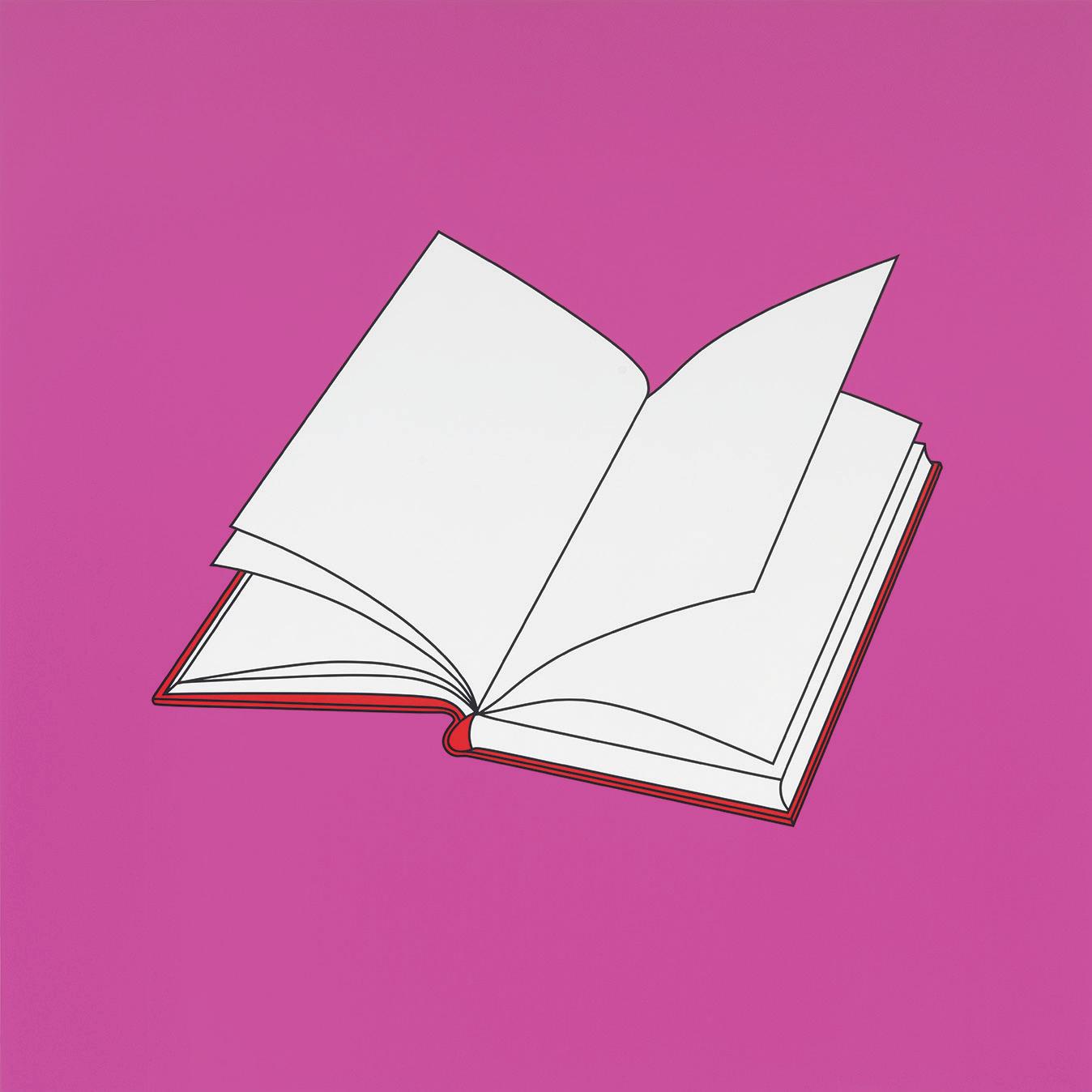
Although Michael Craig-Martin is probably best known for his vibrantly coloured images of everyday objects, he focused after his graduation from art school at Yale University in the 1960s on conceptual sculptural works devoid of colouring because, in line with the spirit of the time, he felt colour represented ‘empty formalism, banal self-expression, the decorative, arbitrary and indulgent’.1
His earliest work here is the modestly sized Black Book (1967; cat. 1), which takes a familiar object, a book, and transforms it into a sculpture that is a hybrid between a book and a box. CraigMartin was greatly inspired by the minimal geometric forms and slick surfaces of Donald Judd’s boxes. But while his box sculptures – developed first in meticulous drawings on graph paper (cats 2–6) –were as minimalist as Judd’s, they also suggested utilitarian qualities in that their hinges and handles invited viewers to interact with them, to open and close them. In Box that Never Closes (1967; cat. 7), the artist plays with the viewer’s expectations and frustrations: the box looks like it ought to close, but it doesn’t. Formica Box (1968; cat. 8) turns out not to be a box at all when it is opened up. The idea here is that it is a sculpture that, as the artist says, ‘you could close and “put away”’.2 These boxes were to be CraigMartin’s last free-standing sculptures until his recent sculptures of drawn objects.
His next sculptures were largely wall-based and take further his interest in simple, mass-produced, readymade objects, among them buckets, milk bottles, pencils, clipboards. Four Complete Clipboard Sets… (1971; cat. 14) and Four Complete Shelf Sets… (1971; cat. 15) invite the viewer to detect the differences between the elements within each set, as the artist adds and subtracts details between them. In a sense, they prefigure Craig-Martin’s much later digital
reworkings of famous paintings, in which the colouring of the digital image constantly changes, with details of the composition fading in and out.3 On the Shelf (1970; cat. 13) and On the Table (1970; cat. 12) play with the viewer’s perception in a different way, suggesting simultaneously both equilibrium and precariousness. In the former, the milk bottles are tilted at an alarming angle, whereas the horizon line formed by the water inside them suggests a safe balance. In the latter, almost as a visual joke, a carefully calibrated balance exists between the weight of the four water-filled buckets and the legless tabletop suspended from the ceiling. In a sense the buckets are supporting the table rather than the other way around. In the mirrors in the ironically entitled Conviction (1973; cat. 16) viewers are invited to reflect on their own perceptions of themselves, prompted by phrases such as ‘I recognise myself’ and ‘I know who I am’ interspersed with question marks. One glances into the mirrors in the vain hope of confirmation.
The most radical and most celebrated work of Craig-Martin’s early career is undoubtedly An Oak Tree (1973; cat. 17), which he presented to consternation from the public and critics at the Rowan Gallery in London in 1974.4 A simple glass of water sits on a wall-mounted glass shelf accompanied by a text in which the artist declares that he has transformed the glass of water into an oak tree. In the artist’s words, the work cuts to the essence of art, revealing ‘its single basic and essential element: belief – that is, the confident faith of the artist in his capacity to speak and the willing faith of the viewer in accepting what he has to say’.5 With this uncompromising work, Craig-Martin had reached a ‘full stop’, as he has described it himself, after which he felt he needed to challenge himself to find a new direction away from conceptual art.

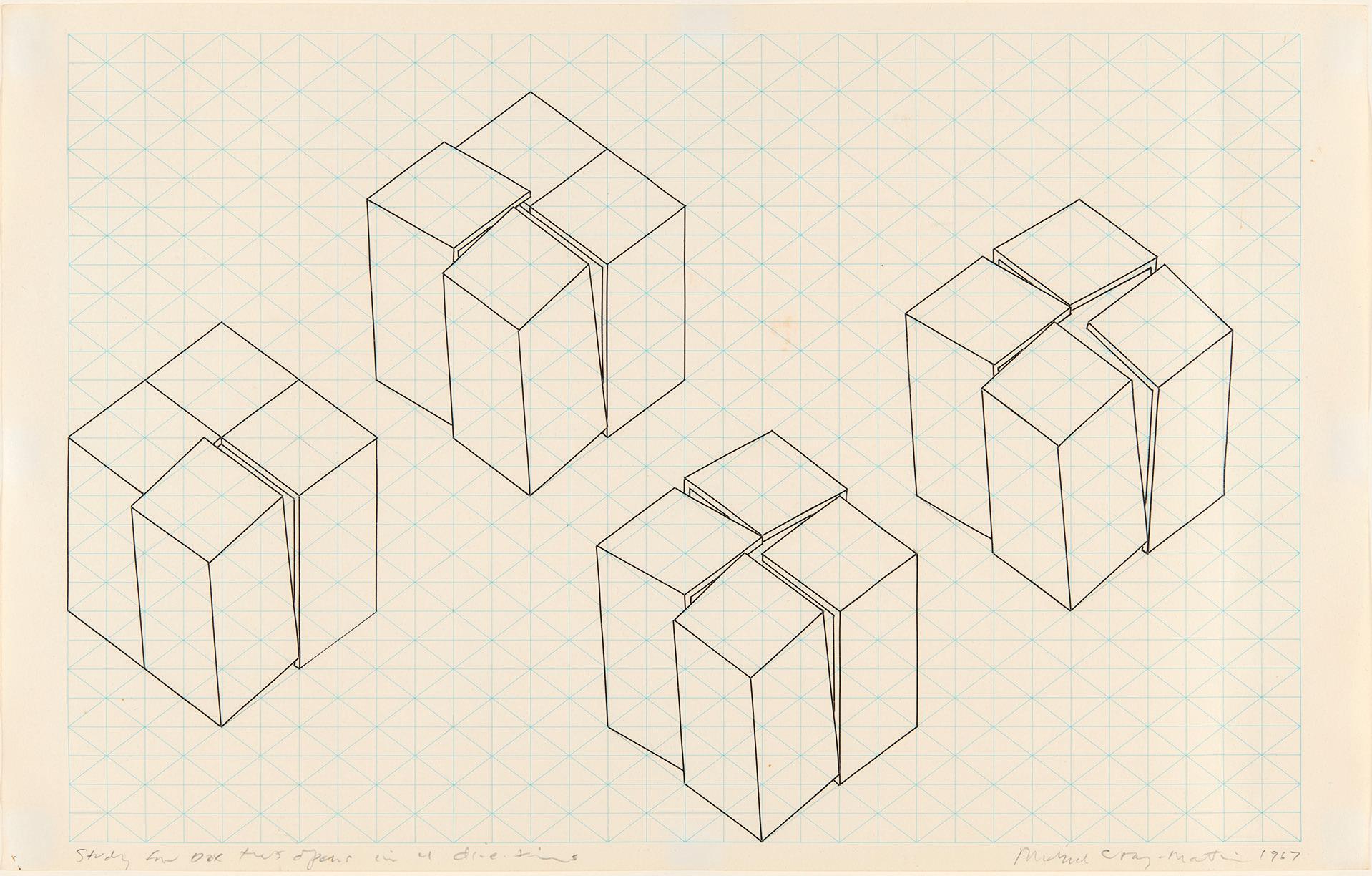
2 Proposal for a group of eight box sculptures, 1967
Pencil and Fablon on isometric graph paper, 43.5 x 56 cm
The Trustees of the British Museum, 2011,7063.1. Purchased with funds bequeathed by Mrs V J Playfair
3 Study for box that opens in four directions, 1967
Hand-applied black crepe tape on isometric graph paper, 28.5 x 45 cm
Collection Irish Museum of Modern Art, Purchase, 2011
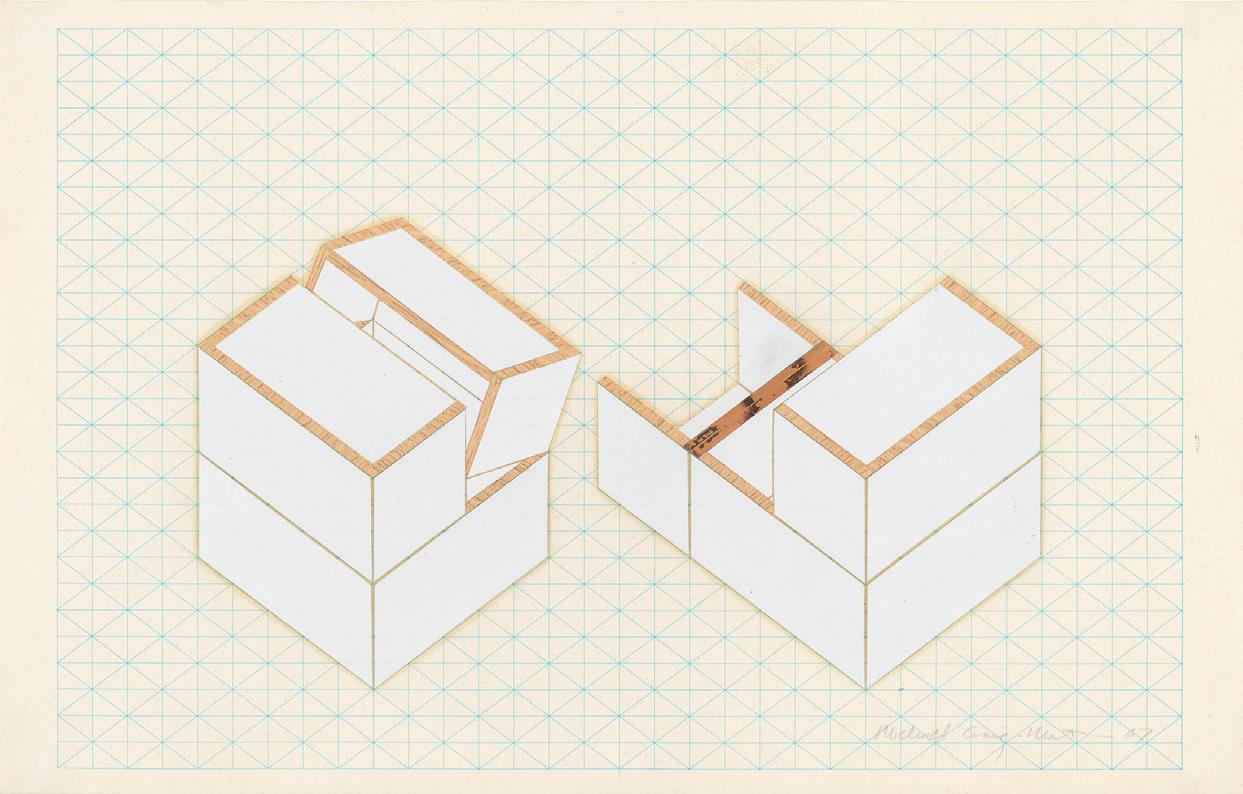
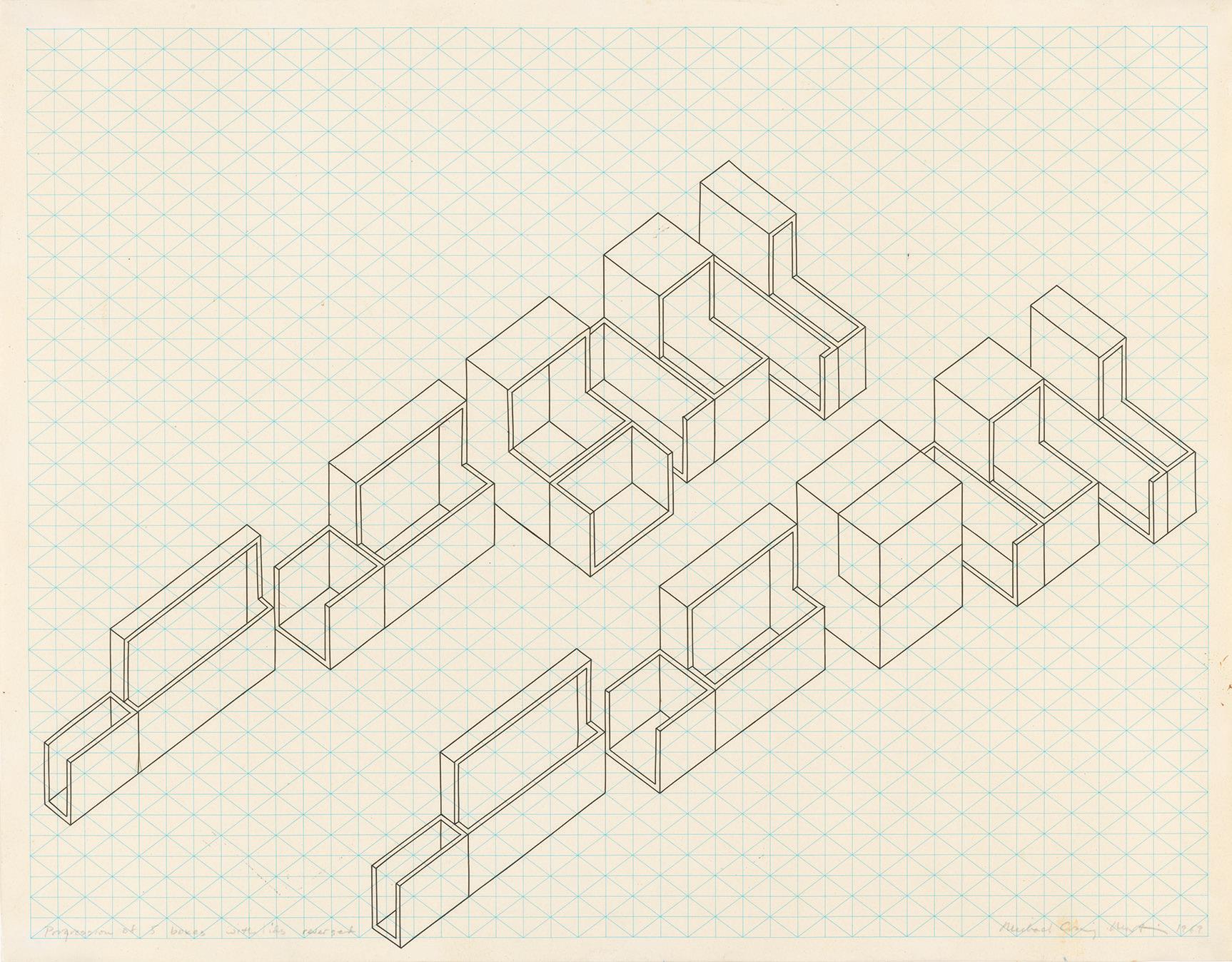
4 Box that doesn’t close, 1967
Pencil and Fablon on isometric graph paper, 40.5 x 27 cm
Courtesy of the British Council Collection
5 Progression of five boxes with lids reversed, 1969
Ink on isometric graph paper, 42 x 54 cm
Courtesy of the British Council Collection
Craig-Martin’s radical approach in both the form and content of An Oak Tree presented him with a challenge to find a way forward in his practice. This he found in pictorial representation and imagemaking. For him, the primary forms of the world, as seen in the earliest art forms, were those of objects in daily use rather than pure circles, squares or triangles. He takes inspiration from objects around him, objects that he uses. This practice echoes that of Vincent van Gogh, who explained in a letter to his brother Theo in 1889, that he insisted on working from the visible world rather than purely from imagination.6
Craig-Martin’s neon works were his first attempts at drawing objects instead of using them. In Pacing (1975; cat. 20), as different segments of the outline light up and go off again, the viewer gets the impression of walking past an open door and seeing, through its frame, parts of another door beyond. In Reading Light (1975; cat. 19), the lamp is always lit up and ‘present’ and becomes ‘more visible’ when the bulb goes on. For a while Craig-Martin was interested in the constantly changing nature of these images, but he ultimately felt his neon works had no future because they were too complicated and expensive to make. This idea of the image that is continuously adjusting, albeit in a very different format, was to return in his digital portraits (cats 134–37), in which the constituent colours go through seemingly unlimited variations.
Craig-Martin’s interest in working with found objects is expressed in his Untitled Painting No. 1 and No. 4 (cats 21, 23) and in Painting and Picturing (1978; cat. 24). He found small paintings in traditional styles by anonymous amateur artists in small London shops and inserted them into sections cut out of the upperleft corners of larger blank canvases. Interestingly, the amateur work in Untitled Painting No. 4 is a copy of one of Monet’s depictions of the Gare Saint-Lazare in Paris of 1877. Here Craig-Martin has appropriated a work by someone who themself appropriated a work by the great nineteenth-century French master. In Painting and Picturing the more complex composition of the inserted still-life prompted CraigMartin to retrace purely the outlines of its objects onto the surrounding blank canvas. Rather than in pen or pencil, he did this in black tape, which was to become his medium of choice for large-scale wall drawings. The work’s title echoes the thoughts of the American philosopher Robert Sokolowski, who coined the term ‘picturing’ for our, as Craig-Martin put it, ‘extraordinary ability to see certain forms as pictures and interpret them as such; without that capacity we would only see coloured shapes… it meant that the viewer of a representational image was not a passive receiver… but was actively implicated in the making of the representation… it allows us to experience the presence of a thing without the thing being present itself.’7 This is perhaps the best summary of CraigMartin’s underlying thinking about his work.


Craig-Martin presented his large-scale wall drawings in a landmark exhibition at the Rowan Gallery in London in 1978. At that time, he was greatly influenced by Duchamp and his readymades, as well as pop art and Warhol. But whereas Warhol concentrated on celebrity, readily identifiable consumer brands and iconic news imagery, CraigMartin continued with his interest in simple, easily recognisable, everyday manufactured objects. To him these were ‘more famous than famous. So famous that you don’t even notice them.’8 He has often commented on the challenge of finding objects that are so generic that they are instantly recognisable without any decorative detail or logos, so that they can be understood as universal representations. He searched for simple outline drawings of them, or ‘pictorial readymades’ as he called them, but to his surprise he could find none. So he started to produce his own drawings of these single quotidian objects. He chose a three-quarter view and showed them slightly from above in order both to indicate their three-dimensionality and to include as many aspects of the object as possible. Rather than using traditional drawing media, Craig-Martin used a crepe tape that had been invented in the 1960s to make drawings of electronic circuitry. He executed the drawings first on transparent acetate and then on translucent drafting film (see cat. 32) with the idea that each drawing could act as a template and be used repeatedly. His technique allowed him to achieve his ideal of making the drawings ‘styleless’, i.e. removing all trace of the artist’s individuality and ‘handwriting’. Craig-Martin wants the viewer to see the image, not the artist, and the linear simplicity of these drawings became his hallmark and the foundation of his work to this day. The transparency of the
acetate allowed him to overlay several drawings to create different compositions to be projected onto the wall, which led to complex, even claustrophobic compositions (cats 25, 28, 33). In Reading with Globe (1980; cat. 25) he arranged the images like the figures in a family or group portrait, while in Modern Dance (1981; cat. 28) he placed four objects drawn in red tape in the foreground as if ‘dancing’ in front of a curtain of images. The same compositional principle the artist also applied in some of his prints, as in the Order of Appearance series (cats 46–49). In most of his works, the objects he depicts, while often densely clustered, retain their individual integrity, but in some of his drawings objects do invade each other’s space and become intertwined in improbably Escheresque compositions (cat. 33).9
After a sabbatical in New York in 1981–82, and inspired by the artist Julian Opie, who was then working as his studio assistant, Craig-Martin started to turn his drawings into wall-mounted sculptures, executed in thin, square-section metal rods (cats 35, 36), usually supported by coloured canvas or metal panels. Only in Globe (1986; cat. 34) does the coloured cube shape completely encase the globe, as if the world had been trapped inside an impenetrable box.
Towards the end of the 1980s Craig-Martin broke away from his dependence on representational drawn images. True to form, he made these new compositions of readymade objects – in this case Venetian blinds (1988–89; cats 43–45) – and mounted them on the wall. He saw them as references to painting, with their rectilinear shapes and solid colour fields suggesting a proximity to American Abstract Expressionist colour-field painting, while the closed blinds – by definition – negate the traditional view of painting as a window onto the world.


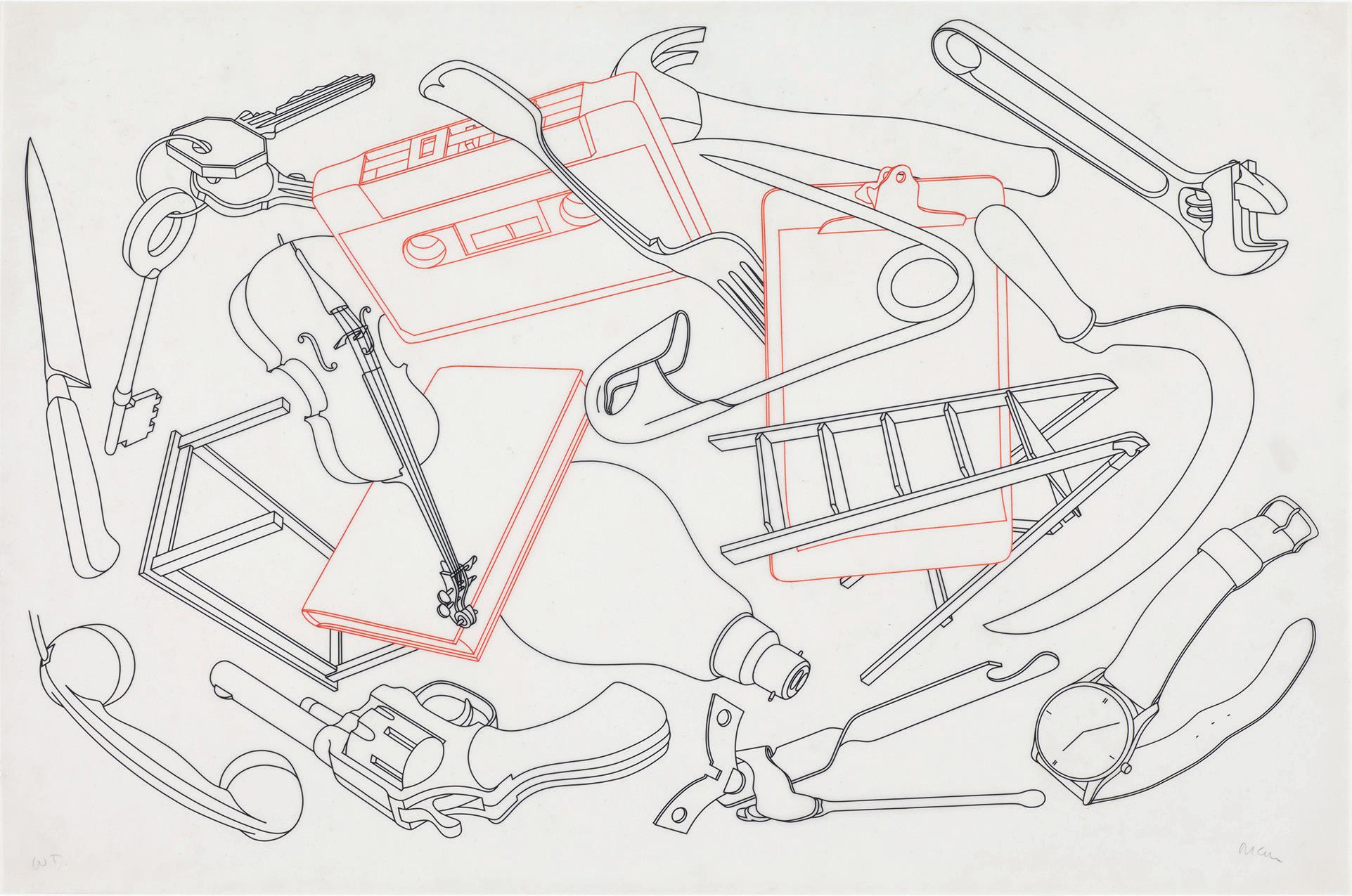

26 Tropical Waters, 1981
Hand-applied black and red crepe tape on drafting film, 60 x 91 cm
The Trustees of the British Museum, 2011,7063.2.
Purchased with funds bequeathed by Mrs V J Playfair
27 Study for Modern Dance, 1980
Hand-applied black crepe tape on drafting film, applied to both sides of the film, 61 x 91.5 cm
Jonathan & Natasha Bowers
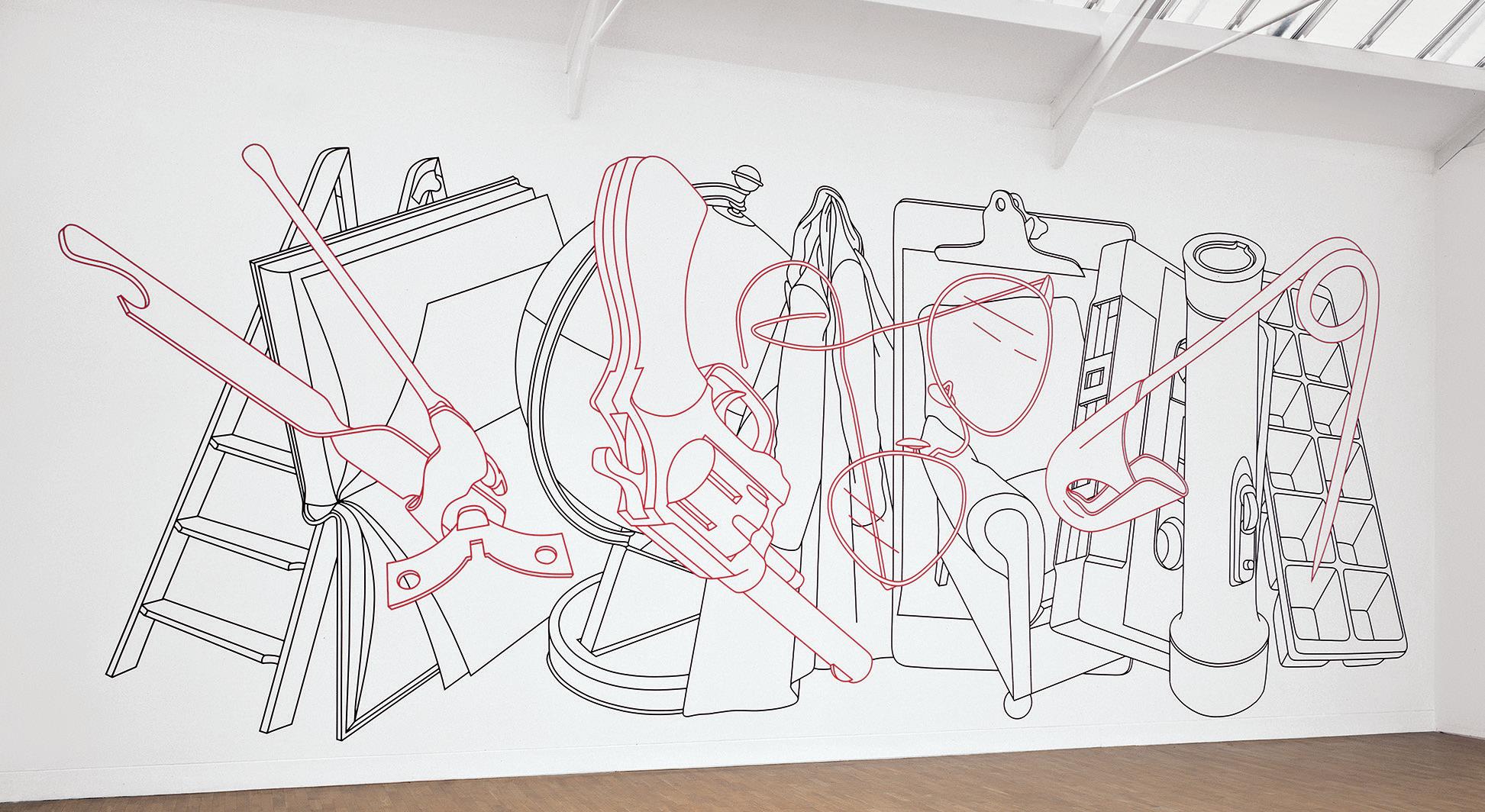

Ms Isabella Lauder-Frost
Jessica Lavooy
Ms Patricia Lawrie
Mr Thierry Le Palud
Lady Lever of Manchester
Eykyn Maclean
Olivier and Priscilla Malingue
Mr Richard Mansell-Jones
Mr Alexis Martinez
Philip and Val Marsden CBE
Mrs Janet Martin
Mr Alexis Martinez
Dame Carolyn McCall DBE
Gillian McIntosh
Itxaso Mediavilla-Murray
Victoria Miro
Mr Alan Morton
Mrs Maggie Murray-Smith
Ms Minka Nyberg
Emma O’Donoghue
Neil Osborn and Holly Smith
Sir Michael Palin
Mr and Mrs D J Peacock
Cynthia Philips
Mr Adam and Mrs Michelle Plainer
Mary Pollock
Lady Purves
Ms Mouna Rebeiz
Peter Rice Esq
Erica Roberts
Miss Elaine Rowley
Mrs Janice Sacher
Mr Adrian Sassoon
Christina, Countess of Shaftesbury
David and Heather Shaw
Ms Elena Shchukina
Dr Shirley Sherwood OBE
Mrs Marianna E Simpson
Mrs Jane Smith
Lady Henrietta St George
Marc and Julie St John
Miss Sarah Straight
Mrs Ziona Strelitz
Mr Robert Suss
Ms Catherine Sutton
Anne Elizabeth Tasca
Ms Sally Tennant OBE
Mr Anthony J Todd
Mrs Kirsten Tofte Jensen
Ms Roxane Vacca
Marek and Penny Wojciechowski
John and Carol Wates
The Duke and Duchess of Wellington
Ms Christine Westwood-Davis
Mr and Mrs Anthony Williams
Mrs Adriana Winters
Yang Xu
David Zwirner and those who wish to remain anonymous
YOUNG PATRONS
Kalita al Swaidi
Dr Ghadah W. Alharthi
Miss Aishwarya Anam
Yevheniya Bazhenova
Mr Nicholas Bonsall
Mr Matthew Charlton
Miss XiaoMeng Cheng
Ms Caroline Cole
Thomas de Noronha e Silva Tomei
Rebecca Dolan
Sophie Dickson
Dr Brian Fu
Rebecca Glenapp
Dr Irem Gunay
Miss Amelia Hunton
Mr Phoebus Istavrioglu
Miss Minnie Kemp
Mr Callum Kempe
Ms Victoria Kleiner
Alinda Kring
Miss Matilda Liu
Mrs Louisa Macmillan
Anna Maj Madsen
Mr Jean-David Malat
Patrick McCrae
Mrs Aytan Mehdiyeva
Jessie Merwood
Miss Yekaterina Munk
Ms Madeleine Murphy
Mr Thomas Mustier
Miss Mimi Nguyen
Mr Garth Oates
Miss Lucinda Bellm, LAMB Gallery
Danielle Petitti
Ms Julie Scotto
Fazilet Seçgin
Irene Sieberger
James Simpson
Lindsay Smith
Gigi Surel
Ryan Sebastian Taylor
Maria Toxavidi
Mr Mattias Vendelmans
Ariana von der Heyde
Miss Lucy von Goetz
Mr and Mrs Harry Walker
Dimitrios Weedon-Topalopoulos
Celia You
Sofiya Zhevago
and those who wish to remain anonymous
PATRON DONORS
The de Laszlo Foundation
Kate de Rothschild Agius and Marcus Agius CBE
The William Brake Foundation
Mr D H Killick
The Michael and Nicola Sacher
Charitable Trust
Ms Cynthia Wu and those who wish to remain anonymous
TRUSTEES OF THE ROYAL
ACADEMY TRUST
Registered Charity No. 1067270
HONORARY PRESIDENT
His Majesty King Charles III
TRUSTEES
Batia Ofer (Chair)
Sally Tennant OBE (Vice-Chair)
President (ex officio)
Treasurer (ex officio)
Secretary and Chief Executive (ex officio)
Clara Amfo
Stefan Bollinger
Aryeh Bourkoff
Melanie Clore
Martin Ephson OBE
Pesh Framjee
Clive Humby OBE
Nicole Junkermann
Dame Carolyn McCall
Scott Mead
Siobhán Moriarty
Paulo Pereira
Lisa Reuben
Robbie Robinson
Bianca Roden
Ina Sarikhani Weston
Katy Wickremesinghe
The Hon William Yerburgh
EMERITUS AND HONORARY TRUSTEES
Lord Aldington
Susan Burns
Sir David Cannadine FBA
Sir Richard Carew Pole Bt OBE DL
Sir Trevor Chinn CVO
John Coombe
Elizabeth Crain
Lord Davies of Abersoch CBE
Sir Lloyd Dorfman CBE
Ambassador Edward E Elson
John Entwistle OBE
Michael Gee
HRH Princess Marie-Chantal of Greece
C Hugh Hildesley
Anya Hindmarch CBE
Susan Ho
The Lady Lever of Manchester
Sir Sydney Lipworth KC
The Rt Hon Lord Luce GCVO DL
Philip Marsden
Sir Keith Mills GBE DL
Ludovic de Montille
Lady Alison Myners
John Raisman CBE
Sir Simon Robertson
Maryam Sachs
The Hon Richard Sharp
David Stileman
Robert Suss
Peter Williams
CORPORATE MEMBERSHIP OF THE ROYAL ACADEMY OF ARTS
Launched in 1988, the Royal Academy’s Corporate Membership Scheme offers company benefits for staff, clients and community partners and access to the Academy’s facilities and resources. We thank all members for their valuable support and continued enthusiasm.
PREMIER
A&O Sherman
BNY Mellon
Cazenove Capital
Charles Stanley
Convex UK Services Limited (Convex Group)
Evelyn Partners
EY
FTI Consulting
JM Finn
JTI
KPMG LLP
Rothschild & Co
Sotheby’s
Van Cleef & Arpels
CORPORATE
Bloomberg LP
Chanel
Christie’s
Clifford Chance LLP
Edelman
Hakluyt & Company
HSBC
Marie Curie
Pictet
Rathbone Investment Management
Ltd
The Royal Society of Chemistry
Sisk
Teneo
Trowers & Hamlins
Value Retail
Weil Gotshal & Manges LLP
ASSOCIATE
Bank of America
Beaumont Nathan
The Boston Consulting Group UK LLP
The Cultivist
Deutsche Bank AG
Generation Investment Management LLP
Imperial College Healthcare Charity
Lazard
SMBC Europe Ltd
CORPORATE FOUNDING
BENEFACTORS
BNY Mellon
Index Ventures
Newton Investment Management
Sisk
Sky
CORPORATE PARTNERS
AXA XL
Bloomberg Philanthropies
BNP Paribas
Edwardian Hotels
Insight Investment
Viking
CORPORATE SUPPORTERS
Amathus
BNY Mellon, Anniversary Partner of the Royal Academy of Arts
Burberry
Claridge’s
Natalia Cola Foundation
Fortnum & Mason
Gide Loyrette Nouel
Hermès GB
House of Creed
L’ÉCOLE, School of Jewelry Arts, supported by Van Cleef & Arpels
Louis Roederer
Stewarts
Tileyard London